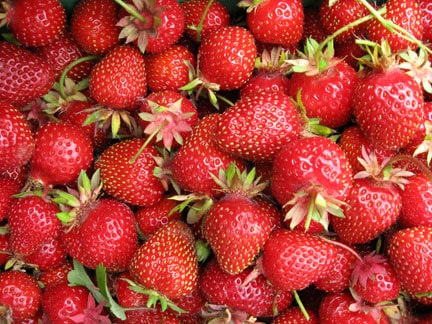No garden treat quite matches plucking succulent berries off of your own berry vines. This expert guide will help you grow your own delicious berries.
Popular berries for home gardens include blackberry varieties and raspberries, which grow on canes; blueberries, which grow on bushes; and strawberries, which can be grown as low plants on hills or as a ground cover, or in pots or hanging baskets.
Once established, the cane berries and blueberries will provide fruit for years. Strawberries, though, will need to be replaced after several years. Each type of plant has its own growing needs and care requirements.
Blackberries & Raspberries
Blackberries grow as either trailing types, with long canes that need to be trained onto a fence or trellis, and erect types, which can support themselves but are neater if tied to an upright.
Both types bear fruit on second-year growth. Raspberries can support themselves but do best if supported on an upright as well. Both blackberries and raspberries prefer rich, well-draining soil in full sun with good air circulation, though raspberries do better in areas with cool, wet summers and cold winters. Avoid sites that have been planted with other cane berries, eggplants, peppers, potatoes, strawberries, or tomatoes.
Set blackberries out in spring. Remove any weak or diseased canes, and then set them about an inch deeper than they were grown in the nursery. Cut them back to 10 inches, and keep the soil most. For erect types, cut the new canes down to about 3 feet high in summer. The next spring, remove any broken or diseased canes, and cut the side branches back to about 12 inches. Cut the canes back to the ground once they’ve finished fruiting. Let the trailing plants grow the first year. The next spring, remove weak or diseased canes, and then prune the canes back to about 5 feet or wrap them around the support. Once you’ve harvested the fruit, cut the fruit-bearing canes back to the ground.
Set bare-root raspberries out in early spring. Raspberries in containers can be set out any time except summer. Remove any weak or diseased canes, and plant them about an inch or two deeper than they grew at the nursery. Leave space between plants. Cut back the canes to 5 to 6 inches. In early spring, before the new buds swell, add mulch around the plants and keep the soil moist, but try to avoid overhead watering, which can lead to fungal diseases. You’ll only need to fertilize if the plants are not doing well.
Prune summer-bearing red and yellow raspberries early in the second spring, before the buds swell. Cut back any diseased, weak, or broken canes, and prune the remaining ones back to about 5 feet and 6 to 8 inches apart. Once the fruit has been harvested, cut the fruit-bearing canes back to the ground.
Prune fall-bearing red and yellow raspberries after they bear fruit in the fall by cutting back the top third of each cane that bore fruit. The next year, after the canes have borne a second crop, cut them to the ground.
Purple and black raspberries, which grow in clumps with arching frames, should be cut across the top the first summer they’re planted to encourage wider growth. Cut black varieties to 2 feet and purple varieties to 2 1/2 feet; if you’re growing them on an arbor, keep them about 6 inches longer. The second spring, remove weak, dead, or diseased canes, and then remove other canes so you have about eight canes in a hill or canes spread 6 to 8 inches apart in a row. Shorten the side branches to no more than 10 inches for black raspberries and 14 inches for purple raspberries. After harvesting, cut back all canes that have borne fruit.
Blueberries, like blackberries, won’t produce a crop the first year but will be dependable and even prolific producers for years to follow. Unlike most other edibles, blueberries like very acidic soil. Plant them in a sunny spot with rich, well-draining soil in fall or winter in mild-climate areas and in early spring elsewhere. For the best start, prune the bush back to three to four strong shoots, and space them 4 to 7 feet apart in rows that are at least 8 feet apart. Add mulch; blueberry roots are shallow and this helps retain moisture.
Water blueberries consistently during the growing season; they need 1 inch of water per week. Drip irrigation is best; avoid overhead watering. Fertilize lightly after the second year with a fertilizer formulated for azaleas and rhododendrons.
Prune plants to prevent them from setting too much fruit. Remove any old and crossing canes. After the third year, cut back canes that are growing vigorously to encourage side branches.
How to Grow Strawberries
Strawberries may be the most popular, and the easiest, berries to grow. Nurseries and your cooperative extension agency will have the best varieties for your area. June-bearing strawberries have a shorter season but generally the best size and taste. Ever-bearing strawberries fruit from summer to fall.
Strawberries prefer a sunny spot with rich, well-draining, acidic soil. Avoid sites where eggplants, peppers, potatoes, raspberries, or tomatoes have been planted in the past three years. Plant either in hills, which result in large and beautiful berries, or in rows, which eventually will grow together to form a ground cover. When planting, keep the base of the crown at soil level. Pinching off early blooms will help strengthen the plant; remove runners if you’ve planted in hills.
Water plants regularly, giving them at least 1 inch per week. Fertilize June-bearing plants lightly in early spring and then heavily after harvest; ever-bearing strawberries need consistent but light feedings. Slugs, snails, mites, and strawberry root weevils can cause problems; strawberries can also be prone to powdery mildew, blight, and verticillium wilt.










 Don Vandervort writes or edits every article at HomeTips. Don has:
Don Vandervort writes or edits every article at HomeTips. Don has:




